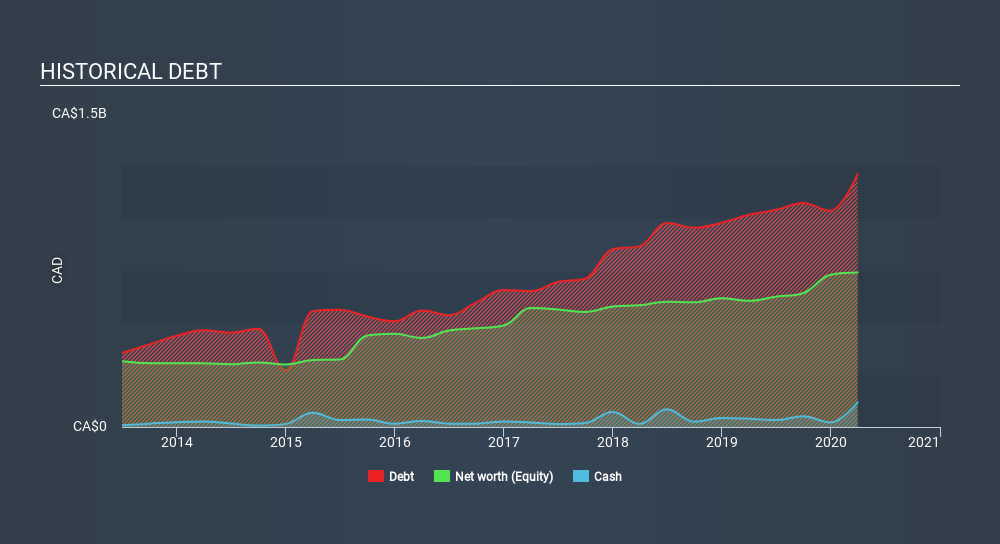Here's Why Exchange Income (TSE:EIF) Is Weighed Down By Its Debt Load
Some say volatility, rather than debt, is the best way to think about risk as an investor, but Warren Buffett famously said that 'Volatility is far from synonymous with risk'. It's only natural to consider a company's balance sheet when you examine how risky it is, since debt is often involved when a business collapses. We can see that Exchange Income Corporation (TSE:EIF) does use debt in its business. But should shareholders be worried about its use of debt?
Why Does Debt Bring Risk?
Generally speaking, debt only becomes a real problem when a company can't easily pay it off, either by raising capital or with its own cash flow. Part and parcel of capitalism is the process of 'creative destruction' where failed businesses are mercilessly liquidated by their bankers. However, a more usual (but still expensive) situation is where a company must dilute shareholders at a cheap share price simply to get debt under control. Of course, the upside of debt is that it often represents cheap capital, especially when it replaces dilution in a company with the ability to reinvest at high rates of return. The first thing to do when considering how much debt a business uses is to look at its cash and debt together.
See our latest analysis for Exchange Income
What Is Exchange Income's Net Debt?
The image below, which you can click on for greater detail, shows that at March 2020 Exchange Income had debt of CA$1.21b, up from CA$1.02b in one year. However, it does have CA$118.2m in cash offsetting this, leading to net debt of about CA$1.09b.

A Look At Exchange Income's Liabilities
The latest balance sheet data shows that Exchange Income had liabilities of CA$284.9m due within a year, and liabilities of CA$1.43b falling due after that. Offsetting these obligations, it had cash of CA$118.2m as well as receivables valued at CA$305.4m due within 12 months. So it has liabilities totalling CA$1.29b more than its cash and near-term receivables, combined.
Given this deficit is actually higher than the company's market capitalization of CA$1.01b, we think shareholders really should watch Exchange Income's debt levels, like a parent watching their child ride a bike for the first time. In the scenario where the company had to clean up its balance sheet quickly, it seems likely shareholders would suffer extensive dilution.
We measure a company's debt load relative to its earnings power by looking at its net debt divided by its earnings before interest, tax, depreciation, and amortization (EBITDA) and by calculating how easily its earnings before interest and tax (EBIT) cover its interest expense (interest cover). Thus we consider debt relative to earnings both with and without depreciation and amortization expenses.
Exchange Income's debt is 3.7 times its EBITDA, and its EBIT cover its interest expense 2.5 times over. Taken together this implies that, while we wouldn't want to see debt levels rise, we think it can handle its current leverage. The good news is that Exchange Income improved its EBIT by 3.9% over the last twelve months, thus gradually reducing its debt levels relative to its earnings. The balance sheet is clearly the area to focus on when you are analysing debt. But it is future earnings, more than anything, that will determine Exchange Income's ability to maintain a healthy balance sheet going forward. So if you want to see what the professionals think, you might find this free report on analyst profit forecasts to be interesting.
Finally, a business needs free cash flow to pay off debt; accounting profits just don't cut it. So the logical step is to look at the proportion of that EBIT that is matched by actual free cash flow. Over the last three years, Exchange Income saw substantial negative free cash flow, in total. While that may be a result of expenditure for growth, it does make the debt far more risky.
Our View
We'd go so far as to say Exchange Income's conversion of EBIT to free cash flow was disappointing. But at least its EBIT growth rate is not so bad. Overall, it seems to us that Exchange Income's balance sheet is really quite a risk to the business. So we're almost as wary of this stock as a hungry kitten is about falling into its owner's fish pond: once bitten, twice shy, as they say. There's no doubt that we learn most about debt from the balance sheet. However, not all investment risk resides within the balance sheet - far from it. Take risks, for example - Exchange Income has 4 warning signs (and 2 which are concerning) we think you should know about.
At the end of the day, it's often better to focus on companies that are free from net debt. You can access our special list of such companies (all with a track record of profit growth). It's free.
Love or hate this article? Concerned about the content? Get in touch with us directly. Alternatively, email editorial-team@simplywallst.com.
This article by Simply Wall St is general in nature. It does not constitute a recommendation to buy or sell any stock, and does not take account of your objectives, or your financial situation. We aim to bring you long-term focused analysis driven by fundamental data. Note that our analysis may not factor in the latest price-sensitive company announcements or qualitative material. Simply Wall St has no position in any stocks mentioned. Thank you for reading.
About TSX:EIF
Exchange Income
Engages in aerospace and aviation services and equipment, and manufacturing businesses worldwide.
Reasonable growth potential with proven track record.
Market Insights
Community Narratives



